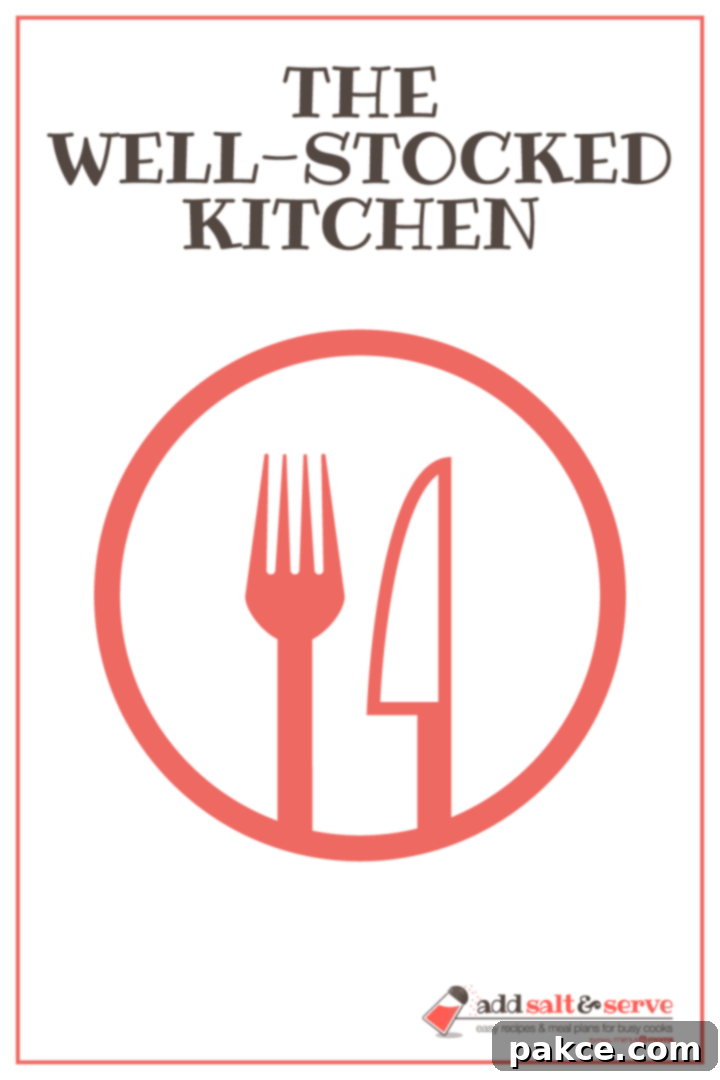The Essential Guide to a Well-Stocked Pantry: Save Time, Money, and Stress
Imagine a kitchen where every ingredient you need is readily available, meal preparation is a breeze, and last-minute grocery runs are a thing of the past. This isn’t just a dream; it’s the reality of a thoughtfully organized and well-stocked kitchen. A well-stocked pantry, along with an intelligently managed refrigerator and freezer, forms the backbone of stress-free cooking and smart household budgeting. While every cook’s pantry will reflect their unique tastes and culinary habits, the core principles of efficient stocking remain universally beneficial.
This comprehensive guide will help you understand the importance of stocking all three key areas of your kitchen – non-perishable pantry items, refrigerated staples, and freezer essentials. We’ll explore strategies for making your kitchen work for you, from smart shopping tactics to innovative storage solutions for even the most perishable items. Remember, the goal isn’t to buy everything at once but to build your inventory gradually, focusing on items you genuinely use and replenish when you find the best deals.
Beyond the Refrigerator: Maximizing Perishables with Your Freezer
Many home cooks mistakenly believe that certain items are inherently “perishable” and must be used immediately, leading to frequent grocery trips and unnecessary food waste. However, your freezer is an incredibly powerful tool for extending the life of many items you might typically consider strictly refrigerated. Mastering the art of freezing perishables is a game-changer for maintaining a consistently stocked kitchen, reducing spoilage, and ensuring you always have ingredients on hand.
Think beyond just fresh meat and pre-made meals. A wide array of dairy products, deli items, and even fresh produce can be successfully frozen until needed. For instance, lunch meat, various cheeses (especially shredded or block cheese, though some softer cheeses may alter texture slightly), and pepperoni slices all freeze remarkably well. Even milk and butter, often overlooked candidates for freezing, can be stored in the freezer to extend their shelf life significantly. When freezing milk, simply pour out a small amount from the container to allow for expansion before freezing. For cheese, consider grating it before freezing or storing it in airtight portions.
This proactive approach extends to fresh produce destined for cooked dishes. Instead of rushing to use up a bulk purchase of vegetables, prepare them for the freezer. Blanching vegetables like broccoli, green beans, or corn before freezing helps retain their color, texture, and nutrients. For items like onions and bell peppers, sautéing them first and then freezing in portioned bags or containers can be a massive time-saver for future casseroles, soups, stir-fries, and other stovetop meals. Imagine reaching into your freezer for pre-sautéed onions, ready to kickstart your dinner!
In my own kitchen, I’ve designated a large plastic basket in my freezer for an assortment of shredded and sliced cheeses, always keeping an eye out for sales to replenish my stock at the best possible price. Another basket is dedicated to those convenient pre-sautéed onions and sometimes green bell peppers, making weeknight meal prep incredibly efficient. Embracing the freezer for these ‘perishable’ staples transforms your ability to maintain a well-stocked kitchen without fear of spoilage, ultimately saving you time and money.
Smart Grocery Shopping: Strategies to Save Time and Money
Once you adopt the habit of keeping a thoughtfully stocked pantry, refrigerator, and freezer, you’ll likely notice a positive impact on your grocery bill. This isn’t magic; it’s the result of strategic shopping. Instead of paying current market price for essential items out of necessity, you’ll be in a position to refresh your supplies only when items are on sale, at their absolute lowest unit price. Here are my best tips for mastering the grocery store and optimizing your food budget:
Shop Your Kitchen First: The Golden Rule
- Always start by “shopping” your pantry, refrigerator, and freezer before making your grocery list. This ensures you use what you have, reduces food waste, and prevents buying duplicates. Only add items to your grocery list that are running low and are essential for your upcoming meal plan.
- Replenish items from the grocery store only when they are on sale at the lowest price per unit. This patience and foresight are key to significant savings over time.
Become a Price Tracker Pro: Know Your Value
- Know your prices: Understanding the typical sale cycle and lowest price points for your most frequently used items is crucial. Don’t be swayed by what merely “looks like” a deep discount. Sometimes, stores inflate the original price before applying a “discount,” making the deal less impressive than it appears.
- A simple yet effective method is to maintain a price tracker. A cloud-based spreadsheet (like Google Sheets) is ideal, allowing you to update it from home and access it conveniently from your phone while shopping. Track items by brand, size, and store to identify true savings.
Eliminate Waste: Buy What You Eat, Eat What You Buy
- Don’t buy what you don’t eat: This applies in two main ways. Firstly, avoid buying more of a sale item than you can realistically use before it expires. Secondly, resist the urge to buy items with “wishful thinking” – those ingredients your family consistently avoids. Food waste is one of the biggest drains on a grocery budget.
- Use a meal plan: A well-constructed meal plan is your strongest defense against waste. It ensures you buy only what you need for planned meals and encourages you to use every ingredient you purchase.
- Plan leftovers into your meal plans: Incorporate planned leftovers for lunches or another dinner to minimize waste and extend your cooking efforts.
Optimize Your Shopping Effort: The Balance of Time and Savings
- When aiming to save money, it’s vital to weigh the energy spent against the benefit received. While shopping at five different stores with a stack of 100 coupons might theoretically save the most money, the significant cost in time, fuel, and energy might not be worth the marginal return.
- I find that comparing prices at 2-3 favorite stores and strategically planning my trip to get the best price on the most expensive items yields the most significant return with a reasonable amount of effort. Focus your efforts where they will have the most impact.
Leveraging Discount Grocers and Outlet Stores
Discount grocers and outlet-style stores are phenomenal resources for stocking your pantry at reduced prices. These stores often sell overstocked items, products with slightly dented cans, or items past their “best by” date (which typically refers to peak quality, not safety) for a substantial discount. Many operate by selling directly from cases, rather than individually stocking shelves, which contributes to lower overheads and better prices for consumers. While many discount grocers accept EBT cards, it’s worth noting that most do not accept coupons, so always check their specific policy.
Small chain stores frequently offer excellent deals on select items. Retailers like Lidl and Aldi are renowned for their aggressive pricing on a wide range of staples, from produce to pantry goods. Other regional gems, such as Sharp Shopper, provide similar discount opportunities. Larger chains like Save-A-Lot, with over a thousand locations, also offer competitive pricing, though perhaps not quite as deeply discounted as some of the smaller specialty outlets. Even dollar stores often carry groceries, but careful price checking is essential here. Some items can be surprisingly good deals, while others might be cheaper elsewhere, so always compare unit prices diligently.
Your Personalized Pantry Lists: Building Your Kitchen Inventory
Building a well-stocked kitchen is a journey, not a destination, and it’s deeply personal. The following posts in this series are designed to give you a foundational understanding of what a comprehensive, well-stocked kitchen looks like in my home. However, remember that your specific lists will (and should!) vary based on your family’s preferences, dietary needs, and cooking style. The key takeaway remains: stock what you use, use what you stock, and replenish strategically when items are on sale.
These detailed guides will break down the essential items you might consider for each category:
- Part 1: The Well-Stocked Kitchen (This overarching guide)
- Part 2: Non-Perishable Items (Long-lasting staples like grains, canned goods, dried fruits, and spices)
- Part 3: Refrigerator Items (Daily essentials like dairy, fresh produce, condiments, and other chilled ingredients)
- Part 4: Freezer Items (Everything from meats and poultry to frozen fruits, vegetables, and those clever perishable items we discussed earlier)
By consulting these lists and tailoring them to your unique needs, you’ll be well on your way to creating a kitchen that supports your culinary endeavors, saves you money, and eliminates mealtime stress. Start small, focus on consistency, and enjoy the benefits of a truly efficient kitchen.
Pin This Guide for Later

